You’ve found the perfect piece of land to start a new construction home development and are ready to get the ball rolling. As any experienced home builder knows, there’s plenty of work to be done before construction can begin. Geology, geography, regulations, prepping foundations, and more will all play a big role in how those new homes can be built. Thankfully, there are some common red flags that builders should be aware of when planning a new development. Paying attention to these possible hurdles can save a lot of time and money in the long run.
Perform a Geotechnical Investigation
Once you have a plot of land slated for development, make soil testing one of your first priorities. Keep in mind that different soils can be found in different parts of a development, especially if you’re dealing with large lot sizes and/or a large volume of lots.
The geotechnical engineer that you’ll hire to perform the soil test will be able to determine if your site is a good contender for a new development. Erosive, expansive, and contaminated soils are all potential red flags that can bring your development to a halt.
Depending on the nature of the soil, you may need to truck in fill material, excavate the land, or more. You’ll want to map out how much time and money will be spent fixing problematic soils.
Hire a Land Surveyor
A licensed land surveyor will be able to give you exact details about the property’s boundaries and dimensions, along with information about the geography of the land. Analyze the surveyor’s reports to determine whether the topography of the land is conducive to new construction and what will need to be done to prepare the land for excavation and building.
Manage Federal Environmental Regulations
Local ordinances aren’t the only concern before breaking ground on a new development. The federal government has put certain environmental criteria in place that have been handed down from the Environmental Protection Agency (EPA). There are laws based on air quality, lead, water, and waste that make having an environmental assessment imperative.
The EPA isn’t the only agency that can derail a new construction development. In San Antonio, Texas, a $15 million road construction project was halted because an endangered species of spider was found. Since this particular spider is officially on the endangered species list, there’s not much that can be done unless construction can resume without affecting the spider’s habitat.
You Build it, We'll back you up.
Learn why so many builders enroll their homes in the 2-10 New Home Warranty Program.
Become Familiar With Statewide Laws
Each state will have its own guidelines that vary drastically from other states based on their unique environments.
A state’s Department of Natural Resources might help regulate endangered plants and animals and have local ordinances that are unique to each town. In addition, zoning laws should be considered as they can easily derail your plans, and some cities have rules in place dictating that a certain percentage of any new residential development must be allocated to affordable housing. Familiarize yourself from the very beginning and enlist the help of an urban planner as they can help with local laws and zoning regulations.

Protect Yourself With 2-10
Once you’ve taken steps to break ground, it’s important to protect yourself from the unexpected. As the industry leader in new-home warranty administration, 2-10 Home Buyers Warranty can help.
A 2-10 New-Home Warranty allows you to fulfill state Statutes of Repose. It can also help protect you against financial troubles caused by soil movement, which is the source of up to 80% of all structural defects.
In addition to protecting your profits and promoting your quality, a 2-10 New-Home Warranty gives you access to 2-10’s Front Line Warranty Service, which can bolster post-closing client experiences.








